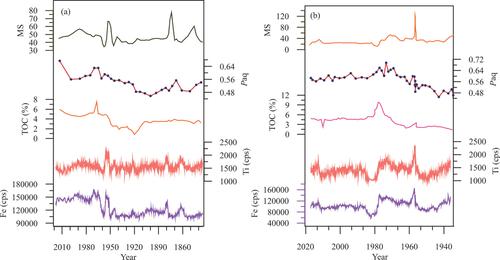当前位置:
X-MOL 学术
›
Acta Geol. Sinica Engl. Ed.
›
论文详情
Our official English website, www.x-mol.net, welcomes your feedback! (Note: you will need to create a separate account there.)
Lacustrine Record of 1954 Flood Event on Begnas and Rupa Lake, Central Nepal
Acta Geologica Sinica-English Edition ( IF 3.3 ) Pub Date : 2020-06-26 , DOI: 10.1111/1755-6724.14543 Sudip ACHARYA 1, 2 , LI Can‐Ge 1, 2 , Kejia JI 1, 2 , Zhe SUN 1, 2 , Mingda WANG 1 , Juzhi HOU 1, 3
Acta Geologica Sinica-English Edition ( IF 3.3 ) Pub Date : 2020-06-26 , DOI: 10.1111/1755-6724.14543 Sudip ACHARYA 1, 2 , LI Can‐Ge 1, 2 , Kejia JI 1, 2 , Zhe SUN 1, 2 , Mingda WANG 1 , Juzhi HOU 1, 3
Affiliation

|
In recent decades, there have been discussions and predictions regarding the impact of climate on floods, due to its socioeconomic and environmental consequences. For accurate prediction of future flood events and their impacts, it is crucial to have an improved understanding on past flood events. Lacustrine sediments have been used as a natural archive to study the past flood events. Here, we study the impact of 1954 flood event on the lacustrine environment of Bengas and Rupa Lake in central Nepal based on X‐ray fluorescence spectrometry (XRF) element analysis, magnetic susceptibility (MS), total organic carbon (TOC) and the biomarker molecular compositions. Results showed that 1954 flood event had significant impacts on the two lakes in terms of detrital input, organic matter deposition and aquatic production. Before the flood event, both two studied lakes had relatively lower catchment erosion rate, lower organic matter deposition and aquatic production. During the flood event, catchment erosion and aquatic production increased in both lakes due to mass transport deposits and the increased nutrition loading attributed to flood event. Following the flood event, Begnas Lake showed the sharp increase in organic matter deposition, whereas in the Rupa Lake organic matter deposition showed minor changes. The difference in organic matter deposition in lakes during flooding event is likely due to detrital material brought and deposited by the flood activity. Overall our results suggest that lacustrine sediments are sensitive to the extreme event and would be an ideal archive for the reconstruction of flood events.
中文翻译:

1954年尼泊尔中部Begnas和Rupa湖洪水事件的Lacustrine记录
最近几十年来,由于气候对社会经济和环境的影响,人们对气候对洪水的影响进行了讨论和预测。为了准确预测未来的洪水事件及其影响,对过去的洪水事件有更好的了解至关重要。Lacustrine沉积物已被用作研究过去洪水事件的自然档案。在这里,我们基于X射线荧光光谱(XRF)元素分析,磁化率(MS),总有机碳(TOC)和生物标记物,研究了1954年洪水事件对尼泊尔中部Bengas和Rupa湖湖环境的影响分子组成。结果表明,1954年洪水事件对两个湖泊的碎屑投入,有机物沉积和水生生产产生了重大影响。在洪水事件发生之前,两个被研究的湖泊都具有相对较低的流域侵蚀率,较低的有机质沉积和水生产量。在洪水事件期间,由于大量运输沉积物和洪水事件造成的营养负荷增加,两个湖泊的流域侵蚀和水生产量均增加。洪灾之后,贝格纳斯湖的有机物沉积量急剧增加,而鲁帕湖的有机物沉积量变化很小。洪水事件期间湖泊中有机物沉积的差异可能是由于洪水活动带来和沉积的碎屑物质。总体而言,我们的结果表明,湖沉积物对极端事件敏感,将是重建洪水事件的理想档案。降低有机物沉积和水产生产。在洪灾事件期间,由于大量运输沉积物和洪灾事件造成的营养负荷增加,两个湖泊的流域侵蚀和水生产量均增加。洪灾之后,贝格纳斯湖的有机物沉积量急剧增加,而鲁帕湖的有机物沉积量变化很小。洪水事件期间湖泊中有机物沉积的差异可能是由于洪水活动带来和沉积的碎屑物质。总的来说,我们的结果表明湖相沉积物对极端事件敏感,将是重建洪水事件的理想档案。降低有机物沉积和水产生产。在洪水事件期间,由于大量运输沉积物和洪水事件造成的营养负荷增加,两个湖泊的流域侵蚀和水生产量均增加。洪灾之后,贝格纳斯湖的有机物沉积量急剧增加,而鲁帕湖的有机物沉积量变化很小。洪水事件期间湖泊中有机物沉积的差异可能是由于洪水活动带来和沉积的碎屑物质。总体而言,我们的结果表明,湖沉积物对极端事件敏感,将是重建洪水事件的理想档案。由于大量运输沉积物和洪灾造成的营养负荷增加,两个湖泊的流域侵蚀和水生产量均增加。洪灾之后,贝格纳斯湖的有机物沉积量急剧增加,而鲁帕湖的有机物沉积量变化很小。洪水事件期间湖泊中有机物沉积的差异可能是由于洪水活动带来的和沉积的碎屑物质。总的来说,我们的结果表明湖相沉积物对极端事件敏感,将是重建洪水事件的理想档案。由于大量运输沉积物和洪灾造成的营养负荷增加,两个湖泊的流域侵蚀和水生产量均增加。洪灾之后,贝格纳斯湖的有机物沉积量急剧增加,而鲁帕湖的有机物沉积量变化很小。洪水事件期间湖泊中有机物沉积的差异可能是由于洪水活动带来的和沉积的碎屑物质。总体而言,我们的结果表明,湖沉积物对极端事件敏感,将是重建洪水事件的理想档案。而在Rupa湖中,有机物沉积显示出较小的变化。洪水事件期间湖泊中有机物沉积的差异可能是由于洪水活动带来的和沉积的碎屑物质。总的来说,我们的结果表明湖相沉积物对极端事件敏感,将是洪水事件重建的理想档案。而在Rupa湖中,有机物沉积显示出较小的变化。洪水事件期间湖泊中有机物沉积的差异可能是由于洪水活动带来的和沉积的碎屑物质。总的来说,我们的结果表明湖相沉积物对极端事件敏感,将是重建洪水事件的理想档案。
更新日期:2020-06-26
中文翻译:

1954年尼泊尔中部Begnas和Rupa湖洪水事件的Lacustrine记录
最近几十年来,由于气候对社会经济和环境的影响,人们对气候对洪水的影响进行了讨论和预测。为了准确预测未来的洪水事件及其影响,对过去的洪水事件有更好的了解至关重要。Lacustrine沉积物已被用作研究过去洪水事件的自然档案。在这里,我们基于X射线荧光光谱(XRF)元素分析,磁化率(MS),总有机碳(TOC)和生物标记物,研究了1954年洪水事件对尼泊尔中部Bengas和Rupa湖湖环境的影响分子组成。结果表明,1954年洪水事件对两个湖泊的碎屑投入,有机物沉积和水生生产产生了重大影响。在洪水事件发生之前,两个被研究的湖泊都具有相对较低的流域侵蚀率,较低的有机质沉积和水生产量。在洪水事件期间,由于大量运输沉积物和洪水事件造成的营养负荷增加,两个湖泊的流域侵蚀和水生产量均增加。洪灾之后,贝格纳斯湖的有机物沉积量急剧增加,而鲁帕湖的有机物沉积量变化很小。洪水事件期间湖泊中有机物沉积的差异可能是由于洪水活动带来和沉积的碎屑物质。总体而言,我们的结果表明,湖沉积物对极端事件敏感,将是重建洪水事件的理想档案。降低有机物沉积和水产生产。在洪灾事件期间,由于大量运输沉积物和洪灾事件造成的营养负荷增加,两个湖泊的流域侵蚀和水生产量均增加。洪灾之后,贝格纳斯湖的有机物沉积量急剧增加,而鲁帕湖的有机物沉积量变化很小。洪水事件期间湖泊中有机物沉积的差异可能是由于洪水活动带来和沉积的碎屑物质。总的来说,我们的结果表明湖相沉积物对极端事件敏感,将是重建洪水事件的理想档案。降低有机物沉积和水产生产。在洪水事件期间,由于大量运输沉积物和洪水事件造成的营养负荷增加,两个湖泊的流域侵蚀和水生产量均增加。洪灾之后,贝格纳斯湖的有机物沉积量急剧增加,而鲁帕湖的有机物沉积量变化很小。洪水事件期间湖泊中有机物沉积的差异可能是由于洪水活动带来和沉积的碎屑物质。总体而言,我们的结果表明,湖沉积物对极端事件敏感,将是重建洪水事件的理想档案。由于大量运输沉积物和洪灾造成的营养负荷增加,两个湖泊的流域侵蚀和水生产量均增加。洪灾之后,贝格纳斯湖的有机物沉积量急剧增加,而鲁帕湖的有机物沉积量变化很小。洪水事件期间湖泊中有机物沉积的差异可能是由于洪水活动带来的和沉积的碎屑物质。总的来说,我们的结果表明湖相沉积物对极端事件敏感,将是重建洪水事件的理想档案。由于大量运输沉积物和洪灾造成的营养负荷增加,两个湖泊的流域侵蚀和水生产量均增加。洪灾之后,贝格纳斯湖的有机物沉积量急剧增加,而鲁帕湖的有机物沉积量变化很小。洪水事件期间湖泊中有机物沉积的差异可能是由于洪水活动带来的和沉积的碎屑物质。总体而言,我们的结果表明,湖沉积物对极端事件敏感,将是重建洪水事件的理想档案。而在Rupa湖中,有机物沉积显示出较小的变化。洪水事件期间湖泊中有机物沉积的差异可能是由于洪水活动带来的和沉积的碎屑物质。总的来说,我们的结果表明湖相沉积物对极端事件敏感,将是洪水事件重建的理想档案。而在Rupa湖中,有机物沉积显示出较小的变化。洪水事件期间湖泊中有机物沉积的差异可能是由于洪水活动带来的和沉积的碎屑物质。总的来说,我们的结果表明湖相沉积物对极端事件敏感,将是重建洪水事件的理想档案。


























 京公网安备 11010802027423号
京公网安备 11010802027423号